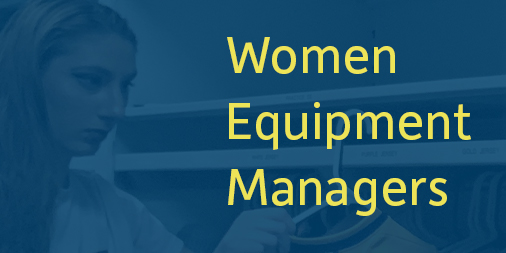
Note: We originally published this article last year as a two-part series.
Women in men’s locker rooms today gains no attention, draws no shock, creates no news.
It’s been 46 years since the first women entered a professional locker room when two female reporters were allowed to conduct after-game interviews in the locker rooms at the 1975 N.H.L. All-Star Game in Montreal.
No one seems to know when the first female Equipment Manager was hired. No one seems to know when the first female Equipment Manager for football was handed the keys. No one seems to know when the first Assistant Athletic Director for Equipment was shown in her office.
Some Things Haven’t Changed for women Equipment Managers
But we found that everyone seems to agree that much has changed in the last several years, and some things have not.
“At one school I worked as a student Equipment Manager and I had to be careful when I would walk into a boys locker room – this was just a couple of years ago,” said one female Equipment Manager we talked with.
“Once, a player shouted my name and, on purpose, dropped his towel in front of me,” she said, with no small amount of disgust clearly in her voice.
“But I have to say, most players were, and are now, very respectful of me.”
Helmet Tracker talked to several female Equipment Managers to find out something about the rewards, challenges, and status of the profession for women. We asked about beginnings, the struggle to advance, opportunities at the AEMA, and other aspects of being a female Equipment Manager.
Here is what we found.
Our Interviews
We talked with Mackenzie Rivers, Assistant Director of Equipment Services at the University of Connecticut where she works with field hockey, softball, men’s and women’s track, and the rowing teams.
We talked with Robin Wert-Eller, Coordinator of Equipment Operations at Franklin & Marshall College, where she works with 27 varsity sports and is the only full-time equipment professional.
We talked with Clifton Perry, Head Equipment Manager at Princeton University and President of the Athletic Equipment Managers Association; and we touched base with AEMA Office Manager Sam Trusner.
We talked with Sherry Ankeny, Equipment Manager at Skidmore College, who oversees all 19 sports, including men’s and women’s. “I’m a one-man show here,” she said, tongue in cheek.
We talked with Kathy Saltis, Equipment Room Manager at Westfield State who recently stepped down as AEMA District I Director to make way for a younger female Equipment Manager to lead. She built the equipment room and equipment program from the ground up there.
We talked with Kayla Modahl, Assistant Equipment Manager at Eastern Carolina University, who works with Olympic Sports, but wants to be in the football equipment room (“I force myself in there to help out when I can.”).
And, we contacted more than a half-dozen additional female Equipment Managers. Some were busy, some were on vacation, some just didn’t respond.
Beginnings – Women Equipment Managers
Most female Equipment Managers began their journey as high school or college athletes, or both. They like the camaraderie that sports create and the excitement of the competition.
Like their male counterparts, they found ways to stay involved—taking paths that may have begun in sports marketing, administration, or aim for the training room. Soon, they find that those paths lead away from the locker room and the activity and the contact with the athletes and the fields.
Many were treated well by their own Equipment Manager. So, some targeted the equipment room from the beginning, knowing it is the career they want.
Others are told to “Go see Ray.”
Go See Ray
“My Mom was like, ‘What are you doing!?’” Mackenzie Rivers told us about announcing her first student equipment management job at Western Connecticut State University.
“YOU’RE doing laundry?”
Mackenzie simply needed a job in college, loved sports, and when she asked around, was told to “Go see Ray in the equipment room.”
She worked with many sports and enjoyed maintaining the equipment. When she graduated from college, she immediately applied to be an Equipment Manager at UConn.
“I really liked it.”
She didn’t get the job, but through the process, she was guided to the Naval Academy where she landed an internship with Greg Morgenthaler, now Associate Athletic Director/Equipment in Annapolis.
After a stint at Binghamton University, Mackenzie did land that job at UConn and has been there for 15 years.
Good Role Model
For Robin Wert-Eller at Franklin and Marshall, a longing to work with equipment and the timely help from a female equipment manager made the difference.
“I was involved with working with equipment while I was in college and when I got out I missed it,” Robin said. “I had a good role model.”
Kelly Jones, Head Equipment Manager at Gettysburg College, was that person.
“Kelly reached out and encouraged me,” Robin said.
She started working part-time nights and weekends, but when the full-time equipment manager left the Diplomats, she stepped in.
Classified Newspaper Ad
Sherry, at Skidmore, has worked in the equipment room for 21 years and has been AEMA Certified for 14.

“I played sports in college (softball at Pace University), but really had never even heard of an Equipment Manager,” she said.
She graduated and landed a business job, but when she and her husband began thinking more about the future, they decided a job for Sherry that aligned better with her husband’s job at a community college would work better.
“We started looking at jobs that I could do and we happened to find an ad in the paper,” she said. “It sounded interesting to me. I got the job and didn’t know anything about hockey.”
Sherry now works with 19 sports.
“When I got the job I didn’t feel like I was out here alone because I was a woman, but because the closest college to us is nearly an hour away.”
The Real Equipment Life
Kayla Modahl, at Western North Carolina, just passed her AEMA Certification Exam this summer in Indianapolis.
“In high school, I worked closely with the football and basketball teams. We didn’t have equipment positions, but I was like a student manager,” she told us.
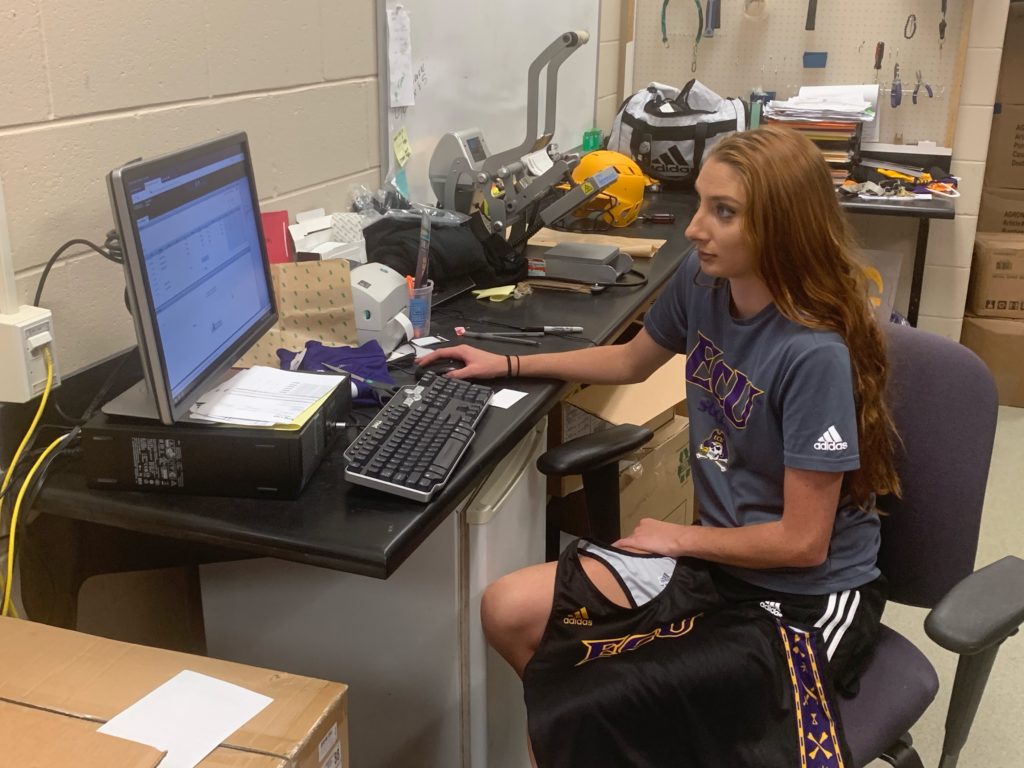
“From there I thought I wanted to be an athletic trainer but found out quickly that wasn’t for me.”
Kayla got a taste of what she calls the “real equipment life” during an internship at Wake Forest.
“I thought it was the greatest thing ever!” she said. “I was really intrigued by the Wake Forest jersey and helmets and cleats and their design and chrome gold helmets.”
She says she forced herself into the equipment room at Miami where she went to grad school.
“I wanted to be right there with the action—interacting with the helmets and jerseys—that’s my big thing.”
“It took about two months to land this job,” she said. “Right now I’m not a football equipment manager technically, but I force my way into helping there. I just show up and start helping out.”
From the Ground Up
Kathy started as a college rowing coach, then decided to return to school and earn her Master’s in Organizational Development. She said she was intrigued by an ad from Springfield College for an Equipment Manager.
“They guaranteed me they would teach me about football and that was the start of my career.”
She had 32 sports programs there and worked eight years before landing at Westfield College.
“The equipment room was just a room. There was not much in the way of organization and not much in the way of understanding of what it could be,” Kathy said. “I built it from the ground up.”
Glass Ceiling for women Equipment Managers?
The female Equipment Managers we talked to told of struggles and difficulties landing jobs and keeping them and advancing. But predominately, these women clearly avoided complaining or blaming. They spoke of the blessings and the goodness and the joy they are rewarded within their chosen jobs.
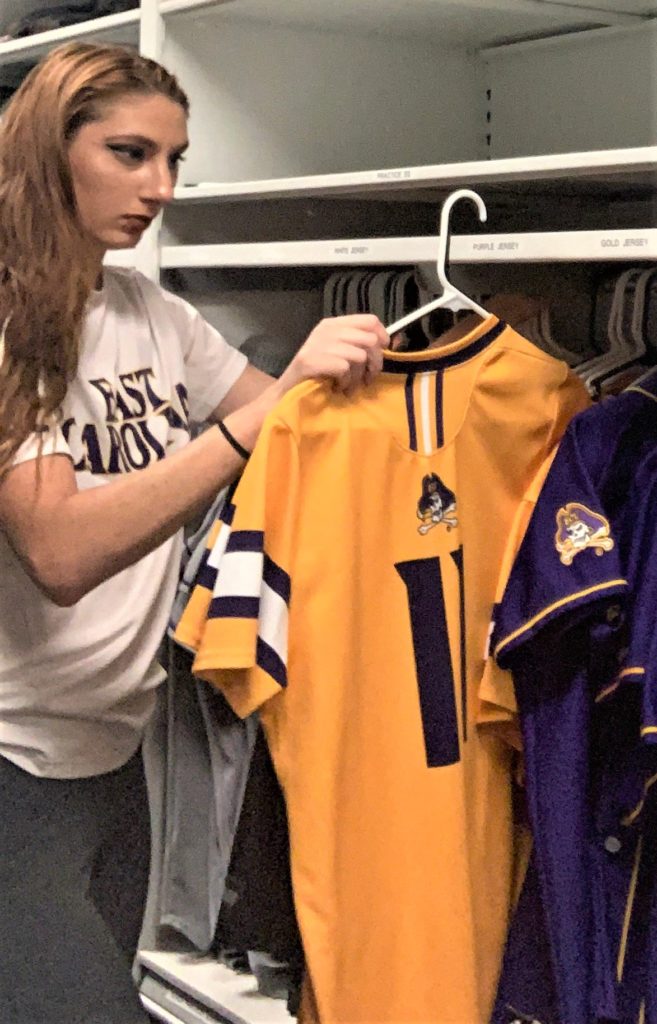
“In some cases, it was helpful being a woman,” Mackenzie admitted. “I know some universities are looking for females to help—though mostly with female sports.
“Begin female could help you at times, and it could hinder you at times.”
Mackenzie, at UConn, believes the opportunities, for the most part, are there for those who are good at their jobs.
“Look, if we weren’t good at what we have done, we wouldn’t be here anymore,” Mackenzie said of being a female in a male-dominated industry. “I would like to think in this day and age that it doesn’t matter if we are men or women, but I’m sure that it does in some places and in some sports.”
Kathy at Westfield State said that while the doors are more open for female Equipment Managers in general than in the past, there are some that still need to be pushed.
“I think there is still a strong feeling that it is fine for women to deal with Olympic sports, but when it comes to football, it is very male-dominated—and even in men’s ice hockey, which I also have, it is very male-dominated.”
Because women Equipment Managers have to deal with males in sports and male Equipment Managers have to deal with female athletes, the challenges are similar, Robin says.
Always Challenges
“I think there are always challenges, but I think the men have challenges too – dealing with the female athletes – it kinda goes both ways,” she said. “However, it’s still not a big career path for women.”
“This job takes a lot of time – nights and weekends – so it’s tough when you have a family.”
Sherry said she doesn’t see the bias often, but it does show itself, and very clearly, at times.
‘You just eliminated ever having a female equipment manager here!’
“Not too long ago I was part of a tour at (a very large, nationally-ranked university football and lacrosse programs she’d rather not have published) a new facility and I had to go to the Equipment Manager after to talk with him. I said, ‘I don’t understand why your locker room and equipment room is set up the way it is.’ This is for men’s lacrosse and football.
“‘The locker room is tied directly to the equipment room,’ I said, ‘You just eliminated ever having a female equipment manager here!’”
“He heard me, but the whole thing was surprising to me.”
Pushing Harder
Kayla, the youngest Equipment Manager we talked with, said she thought being a female may have negatively affected her, but not as much as other aspects of who she is.
“I definitely felt like I had to push a little harder, but not directly because I am a woman but more about my frame. Between me and a guy that can lift 150 pounds, who is more helpful to load a truck?” she said.
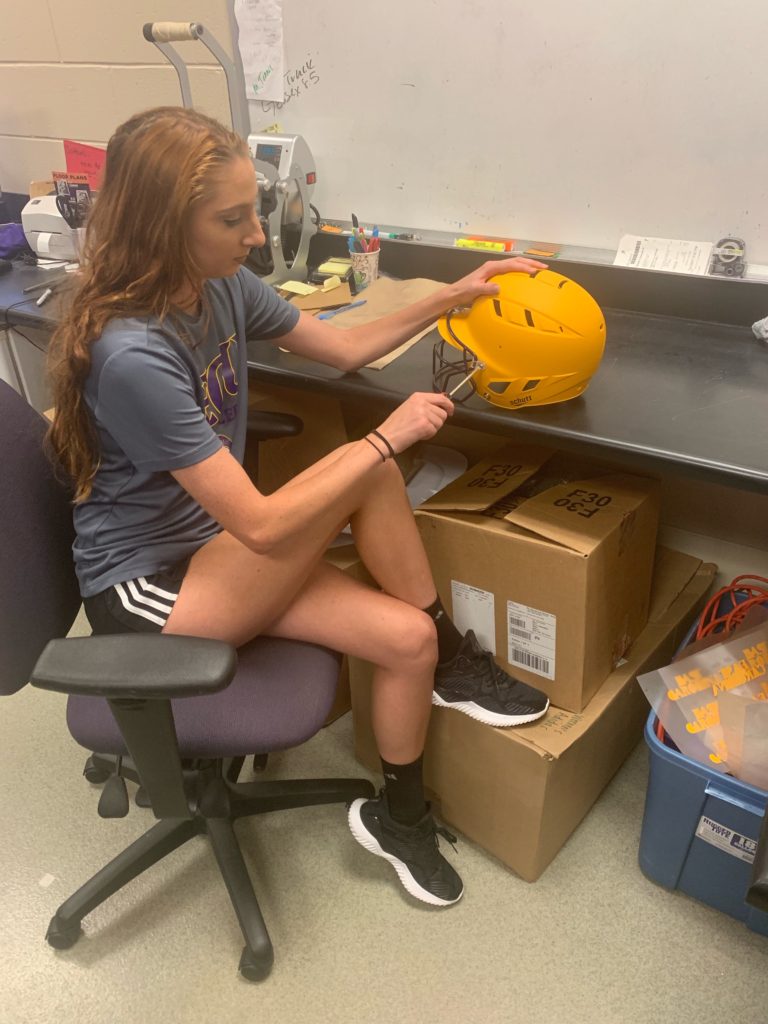
“As far as me being a woman and being around the sport, I don’t think I had too many barriers.”
Robin described the gender bias as much more subtle than it may have been in the past.
“I think there is still a tendency to think this is a male-dominated profession, but there are enough women who have done it and done it well, that the door is open,” Robin said. “However I am in DIII and I can’t say if at D1 that would be the same.”
DIII vs. DI
Mackenzie, who works at a D1 school, admits that the barrier more difficult to vault nowadays is not the gender issue, but the jump it takes to go from a Division III school to D1.
“It is so hard to get in,” she said. “I feel like once you are in, you’re in, but if you mess up, it’s very hard. College athletics is huge, but it’s small because everyone knows everyone.”
“In the end, I think the opportunities for females are the same…,” she said. “Maybe some people don’t think we are as capable, but I think sometimes we see the detail a bit more.”
She goes on.
“I struggle to say that any difference is because of being a female. Our bosses here have not treated us any differently, though I think we are fortunate in that.”
Next week we continue the story about what we found by talking with several women Equipment Managers. We will bring you perspectives on dealing with male athletes, the AEMA, the pay gap, and what advice these women Equipment Managers would give their younger peers.
Dealing With Male Athletes
“Being female in this profession never really crossed my mind early on,” Mackenzie said. “At Navy, those guys in football were never in a rush to get out of the locker room and when we needed something I had to wait—I couldn’t just go in there.
“But the longer I do this, I have ways now of moving things along. The boys here are usually pretty good about things.”
Nearly every female Equipment Manager said something along these lines: “I am not your mother. I will not treat you like that and you will not treat me like that,” as Mackenzie said.
Admittedly, we’ve heard male Equipment Managers say the same thing to their athletics – “I am not your mother.”
Mackenzie admitted there have been young athletes with some attitude problems around her and her female co-workers.
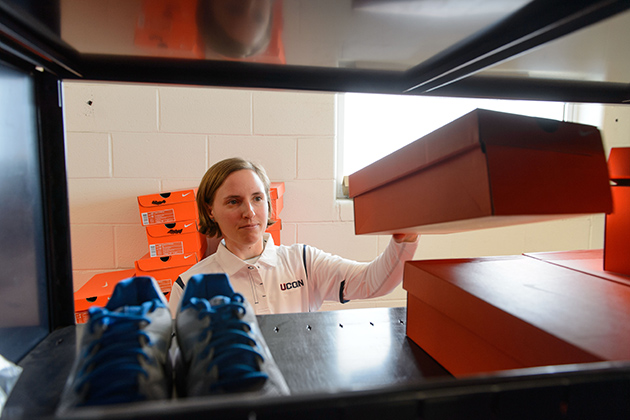
“Look, I’ve had that at times,” she said. “But I don’t think that was because I was a woman—it’s because that kid was a jerk.”
“These are kids. These are 18, 19, 20-year-old who think they are being funny and they are not.”
Female Equipment Managers Questioned
Mackenzie said she sees female student Equipment Managers pressed and challenged, but it is not much different than how male student Equipment Managers are similarly made to prove themselves.
“We have definitely had some pain the ass kids, that’s going to happen,” she said. “But we also don’t have any problem going to the coaching staff and telling them a certain kid needs some talking to.”
For Kayla, it’s the female athletes mostly who question her about her job choice.
“This is my first year working totally with female athletes and that’s great, but it’s definitely different,” she said of her work at Eastern North Carolina. “I feel like the girls are a little more surprised that I am an Equipment Manager than the guys.”
She said football players especially are used to having student Equipment Managers who are female.
“With the women’s teams, I get asked why. ‘Why would you want to do this?'” she said. “Some girls don’t see the appeal of being at all the sporting events and not being there to be cute and dressed up.”
“I have a good relationship with most of my athletes – it’s not an issue.”
AEMA for female Equipment Managers
All are associated with the Athletic Equipment Managers Association. The AEMA counts nearly 1,200 members, draws about 500 to its annual Convention, and certifies Equipment Managers through an initial exam and continuing education.
Many colleges and universities now require their Equipment Managers to be certified or to gain certification within a year of taking the job. AEMA Certification means something and its importance is growing.
We asked our panel about their experience in the AEMA.
Mostly Men Here
Kathy first confronted the lack of women Equipment Managers at an AEMA convention.
“When I went to my first convention as an Equipment Manager, that’s when it hit you in the face – there are mostly men here.”
“When I took the certification exam – as I recall – they wanted input on whether it was a fair exam for women to take and I had to ask, ‘Why wouldn’t it be? We do the same job and yes I do deal with football.’”
Much has changed and progress has been made, Kathy said, but not enough.
“Since that time, in my opinion, it has not evolved enough. This is still a male-dominated field.”
Robin is the Continuing Education Committee Chair of the AEMA, an important and influential position. Still, she believes there is somewhat of a barrier to the higher positions.
“In the AEMA, yes, there is an opportunity for women. Yet, there is a bit of a glass ceiling—I think that is probably true, too,” she told Helmet Tracker.
AEMA President
Clifton Perry, the AEMA President, treads lightly on the issue.
“I wish I had a female Equipment Manager,” he said. “I have almost 500 student female athletes and I don’t have a female Equipment Manager.”

Across the organization, however, Clifton says the number of female Equipment Managers is growing.
“I think there need to be more women in this profession and I encourage more women to get actively involved in the AEMA,” he said.
The barriers are there, he admitted. “Some women feel like they are behind the 8-ball at times and have to work twice as hard.”
Clifton admitted there were no specific programs or efforts to recruit women into the profession or the organization, yet said progress is needed.
“We should be evolving quicker in this,” he said.

Sam Trusner, the AEMA Office Manager, says membership lists do not specify gender so any survey of the membership to see if the female enlistment has grown would be guessing.
Still, he says it is clear the number of female Equipment Managers is growing.
“Many more are getting involved and the more experienced are being hired as head positions and in administrative roles,” Sam wrote us.
Gender Pay Gap for female Equipment Managers
Last year’s AEMA Salary Survey found a gender pay gap for Equipment Managers, but not nearly the size of the national gender pay gap.
Women Equipment Managers averaged nearly 9 percent less pay than men, according to the survey. A 2018 study suggests that national pay gap seems to be somewhere around 20 percent and a 2020 study by Noel Griffith, Ph.D., states “Women Earn 79 Cents for Every Dollar Men Earn“. Female Equipment Managers are doing significantly better than some of their counterparts in other industries. Clearly, however, there is work to be done.
The gender pay gap for Equipment Managers may be affected to some degree to the longer tenure of older men in the industry. Those with more experience are simply paid better.
“Overall, in our association, Equipment Managers are predominately white and male, so those numbers are skewed,” said Matt Althoff, AEMA Associate Executive Director who administered the survey. Matt is Director of Equipment at the University of Virginia and talked with us last summer about the survey.
The 11-question survey found the national average salary for Equipment Managers of $52,575, a nearly 20 percent increase over the average from five years previous.
AEMA Leadership
Kathy said there have, for many years, been female Equipment Managers in important positions at the AEMA. She cites Robin as Chair of the Continuing Education Committee and Kelly Jones, the Chair of the Certification Steering Committee.
“There have always been strong leaders there, but it’s never been embraced in the quite the same way as some of the male roles have been embraced,” she said.
What would that look like?
“I think what it would look like would be years where there might be a female President or female Executive Director—so that it is not always going to be a man.
“It would look like the Glenn Sharp award going to a female in the profession—more than twice in 40 years.”
Networking
Kathy told us that women have begun to gather at the AEMA conventions with purpose.
“It started with a time slot at the national convention to organize a meet and greet and to share a little bit about where women are at in different organizations,” she said. “The goal was to be a mentoring program for younger female Equipment Managers.
“I don’t know if it has developed into that specifically – but more of a network.”
We asked if it would be accurate to call the gather a caucus—a group seeking political-type influence in the AEMA.
“We are not motivated to create power in the organization, but there can be unique issues that female Equipment Managers deal with because they are, in some circumstances, women dealing with male athletes, male-dominated sports, and male coaches.”
She, and others, said the goal of the coalition is networking.
“We want to network with others to find out the most effective way to do things.”
Advice
We asked what these Equipment Managers would tell a young woman getting started as a Student Equipment Manager or someone who wants to make it a career.
Kathy at Westfield State said she would not discount starting small.

“I think that tone of the things I would suggest they do is to check out their local equipment room, to see what the coaches would say they need in the way of support,” she said. “It may be easy to look at a D1 program and say ‘I really want to be involved,’ but sometimes the best place to jump in is a place where you deal with more than football.”
Robin at Franklin and Marshall said staying current is important.
“I would advise her to do research, keep up her education, and be up to date with some of the trends in what is going on,” she said.
Keep At It
Tenacity is at a premium.
“Just keep at it, and stick up for yourself. There have been times that coaches didn’t speak well to me and vendors who didn’t take me seriously. You have to carry yourself with professionalism and if someone treats you condescendingly, take it up with their boss or yours.
As for Kayla, she said she hasn’t met many female equipment managers but hopes to help other young women succeed in the profession.
“I hope to become a role model for others.”
Note: Special thanks to Kayla Modahl for sharing photos of her in her equipment room with us for this story.